Cover Story
Breach of promise
Delayed deliveries leave China Airlines without “the sharp weapon” of new aircraft necessary to become a leading global airline, Kao Shing-Hwang, tells Tomasz Sniedziewski.
June 1st 2025
China Airlines (CAL) chair, Kao Shing-Hwang, went straight to the point. Read More » He is not very happy with one or two aerospace manufacturers. Their delays in delivering aircraft CAL has ordered is holding back the carrier’s goal of becoming a global leader in the industry
He told Orient Aviation he “needed a sharp weapon” to complete his dreams of transforming Taiwan’s flag carrier into a cutting edge and sustainable airline. And that sharp weapon is promised new aircraft yet to arrive in Taipei.
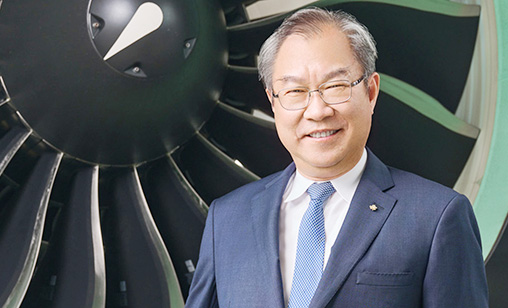 |
Despite this critical and pressing problem, Kao, who is known for his easy manner and openness, found time to talk to Orient Aviation and explain that his 39-year plus career with CAL had honed his management philosophy and influenced his vision for the carrier.
“When I joined China Airlines, my first job was as a flight attendant. It gave me a lot of chances to meet people, to deal with real people and not just the flight instruments as pilots do,” he said.
“Actually I have really enjoyed both flying jobs,” Kao said. “Each time, when we welcome new cadets, they talk about their dreams of being a pilot. In some sense, it is a dream with challenges.
“When you sit in the pilot’s seat, there is a lot of pressure on you. You cannot avoid it. You cannot escape it. Every minute in a cockpit is really hard work as you constantly need to keep alert.
“The job is not about the idea you can travel all over the world, visit nice places and enjoy all the food. That is a side dish. The main job is strictly in the cockpit and you need to take it very seriously.
“So when I was in the cockpit I never relaxed. It is similar to my job in the office,” he said.
“When I jumped into the managerial chair, I knew what my people in the front line were doing so I was able to give my biggest support to my staff.”
Kao added: “Another benefit of being a pilot is the training. It can be applied to management roles. It requires the quick response, always the quick response, and it has to be the correct response. If you are going in the wrong direction with the quick response, then you will have a disaster.
“When I am in a cockpit, my responsibility is about 300 passengers on board. That is the life or death factor, so I am very careful to take the right decisions. Now, when I am working at my desk, I am dealing with decisions involving more than 10,000 CAL staff. That is the level of responsibility I am facing.
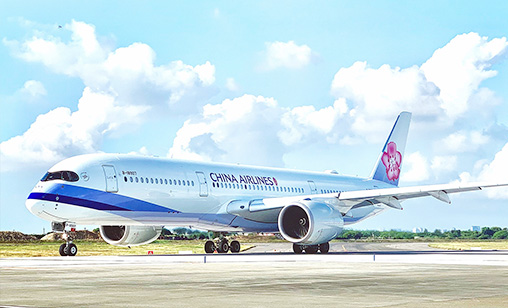 |
“I am always asking myself to do the best to keep the company running, providing a living for my employees and making the business more sustainable.
“This company is not run by me. I need teamwork and I have a wonderful team. During COVID this team came up with a lot of ideas that helped the company make it through the pandemic, especially ideas produced by the cargo department. This is why we not only survived the pandemic, but why we made a profit.”
The profits have kept coming. In 2024, China Airlines delivered its best financial performance in its 65-year history.
“During the pandemic we took important decisions to improve the structure of the company,” Kao said. “If you are not strong enough, the virus will more likely attack you. If you are strong, a virus will probably not get close to you. But even if the virus attacks you, the symptoms will be milder when you are strong.” Kao knew CAL had to be stronger.
“During the pandemic, we restructured finances and we restructured operations. We tried to make the company healthier. We did not just focus on cargo,” he said.
“The pandemic is over. Every market we look at, we can notice the ongoing recovery. We finalized the contract for the 787-9s in 2022. The deliveries were supposed to start this year, but so far we have received nothing. The situation is the contract was finalized three years ago, but the aircraft are not here yet.
“Boeing representatives say the 787 deliveries are still on track, but I think they will be further delayed because the supply chain shortage issue is not resolved.
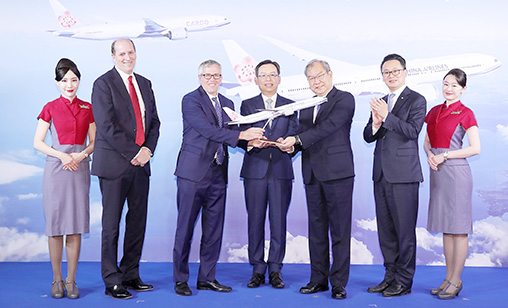 |
“This is a problem. We survived the pandemic, but we are still in the critical moment for the operations and business. Why? Because I am short of the weapon. I am short of the airplanes. That makes our business a little bit critical.”
CAL is systematically accepting A321neo with 11 more of the type to arrive at the airline by year-end 2027. This year, CAL was due to accept its first 787-900, from an order of 18 of the variant, and six 787-10s. In 2029, it expects to welcome the first of 10 A350-1000s into its fleet and a year later to accept its first 777-9 and also two 777-8F freighters. But with some exceptions, deliveries are being pushed out from the promised dates.
“The volume of passenger and cargo did not go to pre-pandemic traffic, but revenue is already much, much higher than pre-pandemic,” Kao said.
“I am thinking if I have enough airplanes I can book much more revenue,” he said, and added the situation is impacting CAL’s position in the Taiwan market compared with EVA Airways and STARLUX Airlines. “The problem is the airline next door. They created more revenue because they have enough airplanes, which we don’t,” he said.
“In this situation, when access to new aircraft in building the competitive position in the market is not an option, one thing an airline can do is use current capacity to its full potential.”
At the recent International Air Transport Association 81st AGM in Delhi, CAL and Southwest Airlines announced a joint trans-Pacific network. Travelers will be able to fly non-stop from Taiwan to the U.S. and then transit to more than 30 cities at four major gateways on the U.S. west coast: Los Angeles, Ontario, San Francisco and Seattle. More domestic destinations are on the partnership’s drawing board. It will allow CAL to offer its passengers access to destinations in the U.S. without using its own capacity.
To preserve capacity, CAL has extended eight A330-300s leases originally planned to be superseded by A321neos and 787-900s. Because of the delayed deliveries, the A330s will fill the gap for longer, even though, as Kao conceded, some CAL passengers are disgruntled with the A330s as they are outdated compared with CAL’s 777-300ERs, A350-900s and A321neo.
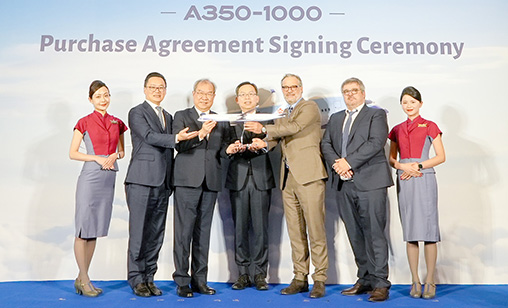 |
“When the A350-1000 is coming in and I have a lot of choice to continue our pattern, which is non-stop, I might have the opportunity to open non-stop to Washington D.C., maybe Dallas or maybe Houston,” Kao said.
“If you make one stop or two stops before you reach your destination there are two kinds of risks. One is you might miss a schedule, miss your plane. Secondly, you might miss your luggage. One stop, these risks are mitigated. Flying nonstop guarantees our service level.”
To maintain that service level CAL will start refurbishing the cabins of its A350-900s, first flown in 2016.
“Each time we order a new airplane, we order the newest IFE systems. “The current generation of IFE is being phased out very quickly. As a result, after maybe eight or 10 years, we cannot find the spare parts for that particular generation of IFE so we keep updating the whole system.”
Post pandemic, Kao said the airline is experiencing strong demand for premium travel confirming the findings of this year’s International Air Transport Association Global Passenger Survey. Affluent YOLOs (You Only Live Once) are travelling more often and in the premium cabin.
“I can see this from the Taiwanese perspective. Real estate prices are very high, so the young generation has no hope of purchasing their own real estate,” Kao said.
“What do they do? They spend all their extra money. They increase their travel frequency and fly business class because they are trying to enjoy their lives.
“Houses or apartments are far away from them in financial means so they give up on real estate. They have some extra money to pay us to travel in business class.”
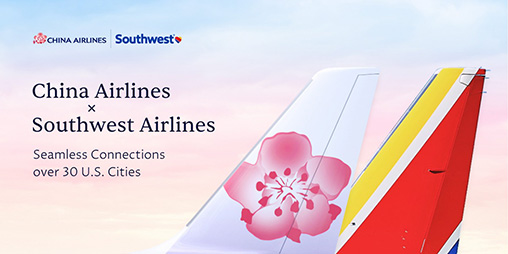 |
CAL is exploring several strategies to cater for its younger generation of customers including co-operating with Michelin Star restaurants to create menus to make their flights “unforgettable experiences”.
“Not only inflight menus but amenities. We have introduced brands favored by young people, such as Roots amenity kits in premium economy, because we have found the average age of our passengers is dropping lower and lower. We need to entertain our young passengers so we have a lot of changes to our flight service,” Kao said.
The changing passenger demographic is being taken into account in the cabins of CAL’s incoming 787s, Kao said, revealing a snippet of information about the anticipated 787 hard product.
“When you enter the cabin, you will recognize it is a CAL product. We will take the existing brand spirit and remodify it a bit. It will not be big adjustments, rather small ones. But as I told you, the average age of our passengers is getting lower, so we will add some more color in the traditional business class.”
Focusing on the preferences of younger passengers is not the only change in the way CAL operates compared with pre-pandemic times.
The airline is more focused on serving transfer passengers through its Taipei hub. “We have reached a new record percentage of transfer passengers in overall air passenger volumes. At the moment, we are targeting fifth and sixth freedom rights. We concentrate on transfer passengers, because the population in Taiwan who want to travel [all over the world] is not so large. So yes, we have really changed our direction,” Kao said.
Pre-pandemic CAL often focused on transporting Taiwanese passengers to overseas destinations with its overseas media campaigns highlighting the beauty of Taiwan as a tourist destination.
Post pandemic, “we will spread around the whole world not merely in Taiwan. Our commitment is we can transport you everywhere you want to go not only Taiwan”, Kao said.
Kao Shing-Hwang joined China Airlines in 1986 as a flight attendant straight out of university. In 1988 he won a place in the flag carrier’s first class of cadet pilots and then progressed through the ranks to captain, check captain and flight instructor. Kao told Orient Aviation this experience allowed him to see the airline’s operations from inside out and not only from the windows of the company headquarters adjacent to Taipei Taoyuan International airport. He joined the management team in 2003 where he was assistant and then chief pilot, assistant vice president and vice president of flight operations and senior vice president. In March 2021, at the peak of the pandemic, he was promoted to president. On Kao’s watch, CAL was one of the few airlines in the world to declare a profit during the pandemic. In 2024, the airline recorded its best financial results in its 65-year history. In March, Kao was appointed CAL’s chair. |
CAL’s latest social media advertising campaigns are targeting travelers seeking connecting flights from Europe to Australia or North America to Southeast Asia.
“Probably we need to encourage people to travel more. After some geopolitical conflicts are over, people may have more urge to go outside their everyday zone,” Kao said.
“They want to look around and see the world. That is our chance. If people stay in the house for too long they will seek traveling and there will be demand created.
“I believe the aviation industry will steadily grow, just as IATA forecasts. So we have a good opportunity to increase flight frequency to some destinations to create more supply of passengers.
“Again, to reach this goal, we need more airplanes to create the network.”
Another result of the pandemic is the popularity of e-commerce that is boosting CAL’s bottom line.
“The pandemic changed cargo demand. Pre-pandemic, people might have gone to shop. Now they are used to shopping at home, used to home deliveries and ordering items online so we do have a lot of e-commerce in cargo,” Kao said.
Although this trend is negatively affected by the introduction of U.S. tariffs Kao believes strong consumer demand will prevail over the restrictions.
Kao said: “There was a little drop after the tariffs were introduced, but I believe it will revert to the previous [growth] trend very quickly.
“Why do I believe so? The original production place may be changed, but the consumer demand is still there. In our cargo routing we just need to redistribute our cargo net to successfully fulfill the demand from people all over the world.
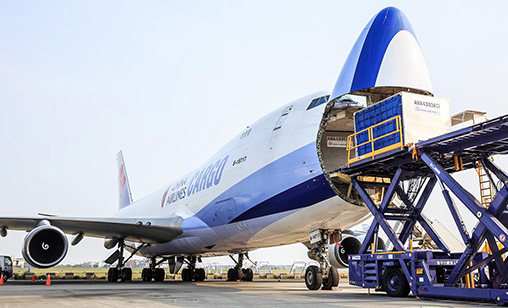 |
“The pandemic changed shopping style and it will help us create more transportation volume.”
Air cargo is acknowledged as the main factor in the company’s success in navigating the pandemic. CAL carried air freight is generating 30% of the airline’s revenue. It delivers more revenue than passenger income because of its lower costs. “You do not need to feed cargo,” laughed Kao.
CAL is an industry leader in pursuing the net-zero by 2050 emissions target and is engaged in multiple initiatives to reduce its carbon footprint.
In 2023, Orient Aviation participated in the SkyTeam Sustainable Flight Challenge Demonstration Flight from Taipei to Singapore where the carrier outlined how it hoped to bring CAL closer to reaching its emissions reduction goal.
Achieving the zero target is an important factor in deciding the future fleet, Kao said. “We are talking about sustainability. What is important for aviation? Emissions. The fact an airplane can reduce fuel burn reduces emissions. If you want to keep the promise to Mother Earth to reduce emissions and meet the net zero target by 2050, the quickest way is to switch the airplane.
“So we have placed an order for the 777-X. Although its range is not as long as the A350-1000, the capacity is greater, so we can carry more passengers, even more than the 777-300ERs we are using today. It translates into lower emission per seat,” Kao said.
Even with the latest fleet, the net-zero by 2050 target is “very difficult for us to reach, or at least we need to work very hard in order to try to pursue that target”, Kao said.
Earlier this year, Taiwan introduced Sustainable Aviation Fuel (SAF) for local carriers. But SAF output and supply is limited so the original goal of using 2% of SAF in all outbound flights has been impossible to achieve, Kao said.
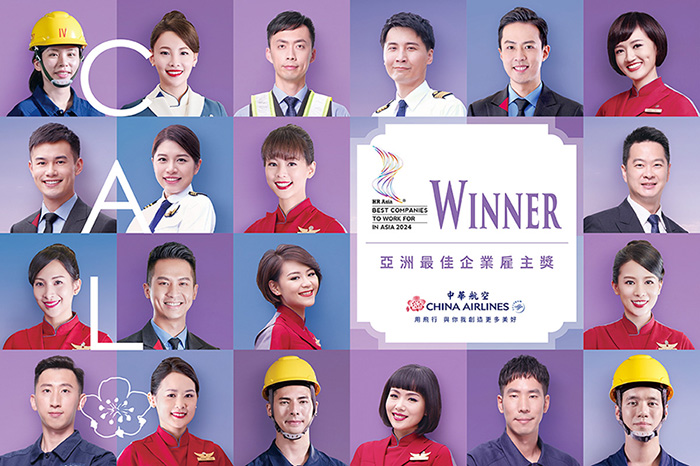 |
Importantly for CAL, there is no shortage of applicants wanting to pursue careers at the airline, an important trend as in the last several years there has been a period of high-tech dominance on the island, exemplified by the Taiwan Semiconductor Manufacturing Company (TSMC). Working for TSMC was viewed by many young Taiwanese as an ultimate career path. In his Taipei Times column, Julien Oeuillet, reported that an 18-year-old said “if you do not work in semiconductors, you are nothing in this country”.
“I can only say the semiconductor industry offers a very good income, but it is not an easy job,” Kao said. “It comes with a lot of pressure and tension. In aviation, there are effective regulations in place that protect pilots or flight attendants from stress and fatigue.”
It is the environment that wins the hearts of people working for CAL. “We do not pay the highest salary, but we offer a chance of a happy life working for us,” he said.
“In our line of job, we can enjoy a lot of engagement with people that makes our job more interesting,” Kao said, and added a large percentage of the CAL workforce chooses long-term employment with the airline group.
Working for the airline comes with several perks of which the most attractive is free airline tickets on standby for employees and their families. The company also operates a bus service with more than two dozen routes to transport staff to and from work.
In 2024, CAL was named HR Asia Best Company to Work for the second consecutive year, beating more than 368 other enterprises. Its reputation as an employee friendly work place is spreading. For every crew vacancy posted, there are 10 applicants, CAL said.
Since Kao was promoted CAL has a new catch phrase: “Leading Asia-Pacific, flying worldwide”.
“That is a goal. It means we have not reached it. It is a target we are pursuing. Why do I say that? Because right now we are short of airplanes,” Kao said.
“Given we have enough capacity, we are trying to lead the market in Asia. In the future, two, three years from now, we can go all around the world.”
Anna Travers says:
September 17th 2025 03:13am